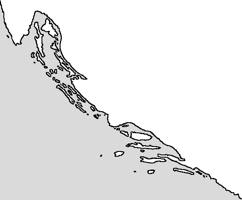
|
The Society of Folk Dance Historians (SFDH)
Choreogeography:
[
Home |
About |
Encyclopedia | CLICK AN IMAGE TO ENLARGE |

|
 The east coast of the Balkan Adriatic Sea is one of the loveliest and most historical places in Europe. From Pula and its Roman Coliseum at the tip of Istria in the north to Croatia's Dalmatia and Montenegro's Sveti Stefan, Albania and Greece further south, rugged mountains set a spectacular separation of blue sky and even bluer sea. Sharp peaks and deep inlets invite the eye to follow and the soul to rejoice in their sheer physical beauty.
The east coast of the Balkan Adriatic Sea is one of the loveliest and most historical places in Europe. From Pula and its Roman Coliseum at the tip of Istria in the north to Croatia's Dalmatia and Montenegro's Sveti Stefan, Albania and Greece further south, rugged mountains set a spectacular separation of blue sky and even bluer sea. Sharp peaks and deep inlets invite the eye to follow and the soul to rejoice in their sheer physical beauty.
The best and worst of both earth and man coexist here: beauty and tragedy side by side, a long history of conquest and exploitation, corruptive wealth and abject poverty, ethnic pride and ethnic hatred, historical splendor and modern squalor.
The remains of Roman Emperor Diaclasias' palace in Split give a hint of the splendor of ancient Rome, built by the emperor so that he could treat his ailments in the area's sulfurous waters.
Zadar's Byzantine church and tumbled Roman columns are mute testimony to the temporary nature of history.
And magnificent Dubrovnik, a jewel of the Balkan Adriatic, the Medieval Ragusa, undefeated by the mighty Ottoman Empire. The lovely walled city stood pristine and undamaged, an unbroken link to the past until severely damaged in 1991 by Serbian gunboats and artillery, one of the most bitter moments in current European history.
 One can sit on the terrace of any hotel along the entire eastern Balkan Adriatic Coast and feel the warm, dry Saharan wind from the southwest, both a curse and a gift, parching the land and providing a climate of almost continuous warm sun.
One can sit on the terrace of any hotel along the entire eastern Balkan Adriatic Coast and feel the warm, dry Saharan wind from the southwest, both a curse and a gift, parching the land and providing a climate of almost continuous warm sun.
Long denuded of trees by the Venetian merchant fleets during Venice's time as Queen of the Seas, the dry coastal side of the mountains contrast starkly to the interior, greened by its damp Continental climate. Centuries of overgrazing flocks of sheep and goats have added further damage. Now vineyards and groves of olive and fig trees color the land in a macroclimate patchwork.
If one looks closely, and listens, the spirits of conquerors and adventurers of two thousand years will speak to you from every view.
The blue waters are dotted by hundreds of spectacularly beautiful islands which boast an average of 300 days of sunshine per year. This combination of warm sun and beautiful scenery is a tremendous attraction to thousands of tourists who flock there to toast bare bodies on hundreds of rocky beaches and more than a few lily white, northern European derrieres have suffered severe sun burn there.
Korčula is perhaps most famous of the islands, green with vineyards and swarming with tourists seeking the birthplace of Marco Polo. Depending on who tells it, he was born in one of several houses in the quaint Medieval town of Korčula. If you're there at the right time of the year, you can even witness a strange sight: the traditional dance of the island was learned from Swedish merchant seamen long ago, a Swedish polska on the fringe of the Balkans!
Though now a part of Croatia, the Dalmatian coast was formerly part of the Venetian Empire and its island traditions are frequently more Italian in character than Croatian. If one is looking for Croatian folklore there, one must be flexible; a multicolored array of dance forms with little resemblance to those of mainland Croatia. Each island has its own unique and readily identifiable dance, music, and costume.
Folk costumes range from some of the most simple and unadorned to the most elaborate, highly decorated in Europe. The simple elegance of Italian-style clothing in the north contrasts remarkably with the unbelievably ornate Turkish-inspired embellishments of the tall Montenegrans in the south.
The dances of the north are invariably couple dances, the man leading and encouraging the lady to spin ever faster to display her billowing skirts and petticoats and, on the island of Krk, lots of leg.
Tall, handsome Montenegrans prefer to mimic the eagle in their dance with enormous vertical bounds and outstretched arms.
This feast of cultures, the sheer beauty of the land, the in-your-face evidence of past and present history are only a part of the Balkan Adriatic Coast. A lifetime is not long enough to experience it all.
DOCUMENTS
- Balkans, a region.
- Richard Duree, an article.
Used with permission of the author.
This page © 2018 by Ron Houston.
Please do not copy any part of this page without including this copyright notice.
Please do not copy small portions out of context.
Please do not copy large portions without permission from Ron Houston.